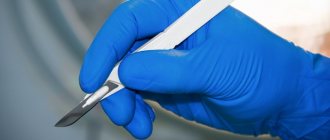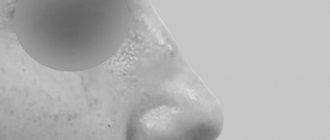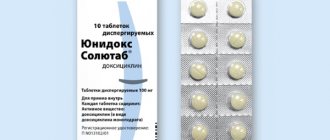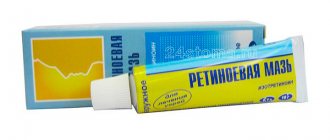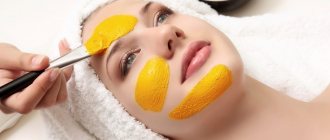What is the cause of inflammation
There are many reasons for the appearance of a cyst: poor hygiene, disruption of the endocrine system, trauma, and damage to the hair follicle. The sebaceous gland, however, continues to function - sebum gradually accumulates under the skin. Microtrauma of the sebaceous gland leads to the same result, as a result of which its communication with the surface of the epidermis is disrupted.
Of course, the presence of excess fat under the skin cannot but have a negative impact on the functioning of the body. Sooner or later, if a person persistently refuses to remove the atheroma, an infection enters the cyst - through micropores, microtraumas on the skin, etc. The cavity is filled with pus, sometimes mixed with blood.
Care for problem skin and treatment of acne using the topical antibiotic Clindovit®
Proper skin care is as important as the selection of therapeutic medications. Morning hygiene for problem skin can be like this:
- Cleansing. You need to wash your face using “light” products, for example, foam or gel. If the manufacturer indicates on the packaging that the product can be left in, it is not suitable for oily skin, as it does not provide high-quality cleansing.
- Toning. The purpose of this stage is to tone the skin and normalize the pH. Lotions and sprays cope with this, which may additionally have antiseptic, anti-inflammatory, pigment-constricting, exfoliating effects.
- Protection. Creams for oily skin can have matting, sebostatic, astringent and other effects. These are products with a light texture and a moisturizing effect. The content of nutritional components in them should be low. It is also important that creams have a high sun protection filter.
Of course, the main role in the treatment of acne is not given to proper care, but to the use of medications, for example, the topical antibiotic Clindovit®. It should be applied to clean, dry skin twice daily6. Clindovit® gel reduces the level of free fatty acids on the skin and exhibits antimicrobial activity against propionibacteria6.
How to understand that atheroma is inflamed
Diagnosing this formation is quite simple - by a black dot on the surface, which is the end of a clogged sebaceous duct. From time to time, contents with an unpleasant odor come out of it. In a non-inflamed state, the cyst does not cause pain, is quite elastic upon palpation and has clear boundaries.
As soon as an infection sets in, it increases in size, turns red, softens - touches bring burning pain, which is no longer possible to ignore. If this focus of infection becomes chronic, the situation may be complicated by an abscess - purulent inflammation accompanied by melting of surrounding tissues, and phlegmon - inflammation of the subcutaneous tissue.
Vulgar acne
One of the most common skin diseases, affecting up to 85% of people aged 12 to 25 years and 11% of people over 25 years of age. Acne can lead to disfigurement and permanent scarring. But even mild cases cause significant emotional distress and have serious psychosocial consequences. Acne is a disease of the hair follicles and sebaceous glands. Four interrelated factors are important in pathogenesis: 1. Pathological follicular hyperkeratosis
– this is a violation of the processes of keratinization, which leads to blockage of the follicular duct by horny scales and the formation of a comedon (black head).
Subsequently, closed comedones turn into inflammatory papulopustular elements and transform into open comedones. In closed comedones, the drainage of sebum and waste products of Propionibacterium acnes is completely blocked. The created oxygen-free conditions are an optimal environment for the rapid proliferation of microorganisms. 2. Excessive formation of sebaceous gland secretion
, which is a substrate for the proliferation of P.acnes, and also leads to pronounced cosmetic defects due to the formation of deep sebaceous cysts (atheromas).
3. Microbial colonization
, in particular the proliferation of P. acnes.
4. Inflammation and immune response
. Acne is not a primarily immune disorder. P.acnes causes inflammation in the dermis (deep layers of the skin), and the epithelium (surface layers of the skin) is damaged by proteolytic enzymes. First, migration of lymphocytes occurs at the site of inflammation. Neutrophilic leukocytes penetrate the lesion and it is they who contribute to even greater damage to the follicle epithelium as a result of lytic enzymes. Highly active radicals (oxygen free radicals, hydroxyl groups, hydrogen peroxide superoxides) accumulate in the dermis, which further damage cells and support inflammation. Inflammation develops at any stage of acne. Today there is no single classification of acne. Existing classifications of acne are based on the clinical picture of the disease or on an assessment of its severity. The most successful is the etiopathogenetic classification. In this review, it is presented with the aim of expanding the understanding of this problem, which will allow us to determine the significance of the disease and optimize the creation of drugs for local and systemic use for the above-mentioned disease.
What should I do?
If signs of inflammation appear, you should not hesitate - you must urgently go to the surgeon. But what you definitely can’t do is squeeze out or pick at the formation, trying to make a hole in it. If a breakthrough occurs and the pus is outside, the wound needs to be treated and wait until it heals. After this, the capsule and contents can be removed. The cyst should not be heated or steamed at any stage - this can cause infection.
At an emergency consultation with a surgeon, it may be recommended to relieve inflammation with levomekol or ichthyol ointment. The product is applied to a clean bandage and applied to the cyst, and then secured with a bandage. The compress is applied three times a day until the process subsides.
Preparations for topical use
Cleansers for certain skin conditions are considered an essential part of the therapeutic plan. In recent years, as a result of chemical synthesis, surfactants called detergents or “syndets” have been obtained, i.e. "synthetic detergents". The fundamental difference between syndets and soaps is that the pH value can be chosen more or less freely. For severe seborrhea, special acne soap is often used, but excessive facial hygiene with frequent washing should be avoided, since overhydration of the follicle leads to the accumulation of sebaceous gland secretions and can cause increased inflammation. Various creams, gels, emulsions, and solutions are used as hygiene and care products for oily skin with a tendency to acne. Shampoos can be divided into cosmetic and medical. Cosmetic shampoos can be liquid, creamy, aerosol, or oil-like. Medical shampoos are used to treat diseases of the scalp and contain antiseptics, active substances, and antifungal agents. For dandruff, the drug of choice is the frequent use of mild detergent shampoos, which are usually used 1-2 times a week. This procedure cleanses the scalp of scales, but in itself does not have a therapeutic effect. Shampoos containing the following components have a beneficial effect (for example: coal tar, ichthyol, piroctone olamine, zinc pyrithione, ciclopiroxalamine, plant extracts, selenium sulfide, AHA, BHA, ketoconazole - an antifungal component). At the multidisciplinary clinic CELT
We take a comprehensive approach to solving problems associated with impaired sebum secretion, using the most modern methods of treating this disease. Remember that self-medication is unsafe, as there is a risk of worsening the problem, therefore, at the first sign of acne, consult a dermatologist! If necessary, the dermatologist will refer you to another specialist (endocrinologist or gynecologist). Our clinic provides excellent laboratory diagnostics, where you can always take hormone tests with a referral from an endocrinologist to prescribe individual treatment. Be healthy, beautiful and cheerful! Make your face a source of pride!
Features of treatment
It is impossible to treat atheroma in such an acute condition. As soon as the inflammatory process can be stopped, the patient will be offered one of the removal methods. Large formations are removed surgically under local anesthesia. By cutting the skin, the doctor removes the capsule, applies cosmetic sutures, after which a scar remains on the skin.
If the cyst is small, a laser will be offered - without contact with the patient's blood. After this procedure, no traces remain. Sometimes it is advisable to combine these two methods - perform surgical excision and treat the capsule with a laser.
If an abscess has formed inside, the surgeon opens the atheroma under local anesthesia, removes the pus and rinses it. To prevent repeated suppuration, a special drainage is inserted into the cavity for several days, and antibiotics are also prescribed. In this case, the formation can be removed no earlier than three months after the wound has completely healed.
Acne classification
A
.
Constitutional acne 1. Seborrheic acne in childhood adolescence and adolescence: - acne of newborns - acne of infants - juvenile acne 2. Late acne: - premenstrual acne - postmenstrual acne - late hyperandrogenic acne in women - conglobate cystic acne in
men
B. Provoked acne 1. Artificial acne (mechanical, traumatic) 2. Oil acne (including professional acne) 3. Cosmetic (can be considered as a contact variant, usually found in women 20-30 years of age who abuse cosmetics). 4. Excoriated (In most cases, it manifests itself in a mild form. Each new rash is squeezed out, scratched or processed with some instrument. A smooth transition of this acne into a disease with abnormal neurotic behavior is possible. Some authors distinguish three degrees of severity of acne: mild form acne is diagnosed mainly in the presence of non-inflammatory elements - closed and open comedones. The moderate form is characterized by the presence of papulopustular elements on the face and torso. The severe form is characterized by a large number of papulopustular elements, as well as conglobate and cystic forms of acne. In recent years, acne treatment has been carried out taking into account pathogenetic aspects and therefore has become more targeted. Diet
... Food does not affect the amount and composition of sebum and the processes of keratinization of follicles. However, individual observations of patients should be taken into account.
Psychotherapy
... Patients with acne often suffer from disfiguring facial changes.
Acne is not caused by mental factors. Acne therapy itself is based on effective therapy, and not on psychotherapy. Psychotherapy that accompanies treatment can help in certain situations. Drug treatment
. Local and systemic therapy is used to treat acne. Topical treatment is indicated only for mild to moderate non-inflammatory acne, mild inflammatory acne without scarring, and as adjunctive therapy for moderate to severe acne. The most actively used drugs, both systemic and local, are retinoids. They act on follicular hyperkeratosis. Retinoids are universal inhibitors of lipogenesis and sebum secretion, normalize keratinization processes, and reduce the inflammatory response. The most well-known drugs are: tretinoin, airol, differin, isotretinoin, lokatsid, retin-A, clinesfar. An isotretinoin derivative, roaccutane, is used as a systemic drug. In addition to retinoids, you can influence excess sebum production with the help of antiandrogenic substances. Most are oral medications. The most famous are: Androcur, Diane-35, spironolactone. The latter can be used in 3-5% concentration, but it, as a rule, has a weak therapeutic effect. Microbial colonization of the follicle is affected by antibiotics and antiseptics, which are used both as local agents and internally. The most commonly used are tetracycline, erythromycin, and clindamycin. One of the options for local anti-inflammatory treatment of acne is curiosin gel. It contains natural components - hyaluronic acid, zinc, substances that are part of many tissues of the human body, primarily the skin. The drug is recommended by manufacturers for the treatment of any form of acne, however, as a result of long-term observations of the practical use of the gel, a lack of clinical effectiveness in its use has been established. In addition to specific local and systemic drugs that affect the pathogenesis of acne, patients often require additional measures (adjuvant therapy).
How to treat
You can get rid of the problem through surgery, laser or radio wave method. The operation is usually planned and does not cause complications. If the formation is small and not infected, it is quite possible to use a laser or radio waves, after which there will be no scars or scars.
The inflamed cyst is first opened, the contents are removed, and after the inflammatory process subsides, the capsule is removed. Patients with a tendency to form atheromas are prescribed a special course of treatment, and in the presence of infection, antibiotic therapy.
If an infection occurs:
- pain syndrome appears;
- the chest swells;
- the skin turns red or blue;
- pus or blood is released from the cyst.
It is this condition that causes the greatest concern for a specialist, because an infection can penetrate into the cavity, and during a consultation with a surgeon, the patient will be prescribed surgical intervention. And this is always fraught with scars and cosmetic defects. If the cyst is located in a place where it is not possible to completely remove it, there is a high probability of relapse. Degeneration into a malignant formation is very rare, but this is not a reason not to pay attention to atheroma, which even without this risk is fraught with many dangers.
What is breast atheroma?
An epidermal cyst, or atheroma, is formed due to blockage of the sebaceous gland in any area where hair grows, including on the mammary gland. On the skin of the latter there are quite a lot of glands that have increased activity. Under certain conditions, the excretion of sebum through the ducts may be impaired: it is this obstruction that causes the formation of a cystic cavity.
Over time, a capsule with a putty-like mass forms in the cystic cavity. The size of the formation can be very different - from microscopic to gigantic, but this does not mean that it is worth finding out prices for atheroma removal only in case of large growths.
Bartholin gland cyst - symptoms and treatment
Small asymptomatic cysts do not need to be treated. They are usually removed only for cosmetic purposes. Only large cysts - from 3 cm or more, which not only disrupt the aesthetic appearance of the external genitalia, but also interfere with everyday activities and sexual life - are subject to surgical treatment.
There is no point in simply opening or puncturing a cyst or abscess. This can lead to relapse, since the edges of the tissues, when punctured or incised, very quickly close again due to the rapid healing process [6].
The main goal of surgical treatment is to preserve the Bartholin gland and its functionality, and to form a channel for the outflow of secretions. There are several treatment options. Let's look at each of them.
Installation of Word catheter
This is a modern method of surgical treatment of cysts. This is especially relevant for its relapses.
Under local anesthesia, the cystic area is opened with a small incision of about 5 mm, after which its contents are removed and sent for bacteriological examination, and then the cyst cavity is washed and a Word catheter is installed into it. It is a silicone tube 55 mm long and 5 mm in diameter, inside of which there is a channel with thinner walls at the end. By inflating its rubber tip to 3 ml with saline solution of 0.9% sodium chloride, the doctor fixes the catheter in the cavity of the cyst. For better fixation and prevention of loss during movements, it is recommended to apply 2-3 absorbable interrupted sutures along the contour of the exiting part of the catheter. The second end of the catheter is inserted into the vagina.
The catheter remains in the cyst cavity for six weeks. This is necessary to form a channel for the passage of secretions, the walls of which will not grow together. The study shows that the Word catheter is easy to use, inexpensive to install, and has acceptable short-term relapse rates [7].
While the catheter is in the cyst cavity, the patient is advised to have sexual rest to avoid its loss. In some countries, there is no such restriction, since studies have shown that the pain symptom caused by both the cyst itself and the presence of a catheter in its cavity completely disappears by the sixth day [8].
As an alternative, a Jacobi ring . This catheter is more solid, it does not have a channel and is presented in the shape of a ring. It is installed through two punctures in the mucosa and capsule of the cyst, and then the two ends of the catheter are secured to each other.
Opening and draining the cyst
Under local infiltration or intravenous anesthesia, the cyst is opened, the cavity is washed with antiseptic solutions, then a rubber drainage is installed in it to drain the secretions. The effect of such an operation is low due to the rapid healing of the incision site and the cessation of outflow from the gland. It can be used only if there is no other method of treatment available or if the cyst has transformed into a Bartholin gland abscess.
Puncture of the cyst
It is performed by puncturing the cyst itself with a needle and then suctioning out its contents. This method of manipulation is carried out in pregnant women or when surgery is impossible.
Marsupialization of the cyst
This type of treatment involves opening the cyst, removing the secretion and creating a new duct. It is used in the following cases:
- if the cyst reappears despite treatment using a Word catheter;
- with a small cyst size;
- if the cyst has several chambers;
- if it is impossible to install a Word catheter.
Marsupialization of a cyst is a simple outpatient procedure. It is performed under local anesthesia for 20-30 minutes. An oval flap 1.5 cm long is cut out in the most convex part. The cyst itself is dissected in the same way, after which it is cleaned and washed. Then the cyst wall is sutured to the labial mucosa so that an artificial duct is formed [13]. The wound does not need to be sutured, as it will heal on its own.
On the second day after surgery, the patient is shown warm sitz baths, and on the third day, stool softeners are prescribed. They are necessary for the prevention of constipation, since hard stool increases pain in the postoperative area, and its stagnation in the colon contributes to the accumulation of harmful microbes that can penetrate through the tissues into the postoperative area. Sometimes antibiotics are prescribed based on the results of a microbiological study. Sexual activity can be resumed in the fourth week after surgery.
The likelihood of relapse after marsupialization is extremely low - about 10%. The operation itself can be performed several times, as it is simple and less traumatic compared to complete removal of the Bartholin gland.
CO2 laser
CO2 laser surgery is also an effective way to treat cysts and can be performed on an outpatient basis. A skin incision is made with a focused laser beam, then the capsule is opened to remove the contents of the cyst, followed by internal evaporation of the damaged capsule [9].
Carbon dioxide provides complete healing in an average of 22 days, with no scars, hematomas or wound infections. You can return to everyday life in about two days. Patients undergoing traditional surgery require 14 days to return to daily activities and 28 days for the surgical wound to heal completely [10]. Due to this, and the minimal risk of complications that may occur during or after surgery, CO2 laser surgery is more cost-effective than traditional treatment [10].
Gland removal
If the cyst recurs frequently with the formation of an abscess, doctors recommend removing the cyst along with the gland [13]. The operation requires great experience and accuracy of the surgeon. It is performed under intravenous anesthesia. Most often performed in a hospital setting.
The incision is made outward from the labia minora, since the opposite side of the mucosa is usually thin, which is why the cyst capsule can be accidentally cut. The cyst is carefully removed using gauze pads while moving away the incised tissue. The gland is also removed. The wound is sutured in layers with absorbable sutures. It is very important to remove the entire gland. Incomplete removal may cause recurrence of the cyst or abscess. If the other Bartholin gland functions normally, then there will be no problems with secretion after this operation.
It should be understood that during the operation the cyst capsule may rupture. This can slow down the duration of the operation and lead to contamination of the wound. Also, the operator may encounter bleeding from the vessels of the cyst bed, but it is easily stopped by applying submersible sutures.
After removal of the Bartholin gland, a rectovaginal fistula may occur - a pathological canal between the rectum and vagina. It appears as a result of ongoing inflammation and “melting” of surrounding tissues.
In this case, patients may complain of pain in the perineal area, which occurs during sexual intercourse and bowel movements. To establish and confirm the diagnosis, you need to contact a coloproctologist, undergo a gynecological and rectovaginal examination, as well as additional examinations. The tissue defect is eliminated using an autograft, a biological collagen plug or a titanium clip. If a fistula is detected during pregnancy, then natural childbirth is prohibited.
